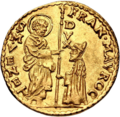Florin

The
History
The fiorino d'oro (gold florin) was used in the Republic of Florence and was the first European gold coin struck in sufficient quantities since the 7th century to play a significant commercial role. The florin was recognised across large parts of Europe. The territorial usage of the lira and the florin often overlapped; where the lira was used for smaller transactions (wages, food purchases), the florin was for larger transactions such as those used in dowries, international trade or for tax-related matters.[4]
The first minting of the florin occurred in 1252. At the time the value of the florin was equal to the lira, but by 1500 the florin had appreciated; seven lire amounted to one florin.[4]
In the 14th century, about a 150 European states and local coin-issuing authorities made their own copies of the florin. The most important of these was the Hungarian forint, because the Kingdom of Hungary was a major source of European gold (until mining in the New World began to contribute to the supply in the 16th and 17th centuries, most of the gold used in Europe came from Africa).[citation needed]
The design of the original Florentine florins was the distinctive
Other coins


The term florin was borrowed elsewhere in Europe. A variant of the florin was the
The Dutch guilder is symbolized as Fl. or ƒ, which means florijn (florin).
The English
In Ireland, a silver florin coin (worth one-tenth of an Irish pound, with Irish inscription flóirín) was minted between 1928 and 1943; it became cupronickel in 1943 and was withdrawn from use on 1 June 1994.[9]
The Hungarian forint is named after the florin.[10]
See also
- Denaro (coin)]
- Florin (Australian coin)
- History of coins in Italy
- Soldo
- Venetian ducat
- Venetian grosso
- Venetian lira
References
- ^ See the Ricordanze di S. Maria di Cafaggio, which mentions florins being used in the year MCCL (1250).
- Leo S. Olschki Editore. p. 66.
- ISBN 978-88-7402-665-4.
- ^ ISBN 978-1-78669-151-4.
- ^ Horner, Susan; Horner, Joanna B. (1884). Walks in Florence and Its Environs. Vol. 2. Smith. p. 125.
- LCCN 67020086.
- ^ John S. Dye (1883). Dye's coin encyclopædia: a complete illustrated history of the coins of the world ... Bradley & company. p. 761. Retrieved 22 February 2012.
- ^ Palgrave, Sir Robert Harry Inglis (1912). Dictionary of political economy. Macmillan and Co. p. 82. Retrieved 22 February 2012.
- ^ Coinage (Calling In) Order 1993 (S.I. No. 270 of 1993). Signed on 16 September 1993 by Bertie Ahern, Minister for Finance. Statutory Instrument of the Government of Ireland. Retrieved from Irish Statute Book.
- OCLC 56676014.
Bibliography
- "Ian Cnulle's Florin". Society for Creative Anachronism Archive. Archived from the original on 11 August 2017. Retrieved 11 March 2023.
- Philip Grierson (1991). Coins of Medieval Europe. Seaby, London. ISBN 1-85264-058-8.
- Peter Spufford (1988). Money and its use in medieval Europe. Cambridge University Press. ISBN 0-521-37590-8.
- Peter Spufford (1986). Handbook of Medieval Exchange. Royal Historical Society, London. ISBN 0-86193-105-X.
- Richard A. Goldthwaite, The Economy of Renaissance Florence [1]
External links
- Money museum:Fiorino d'Oro
- History of the British Florin Archived 2013-05-24 at the Wayback Machine

